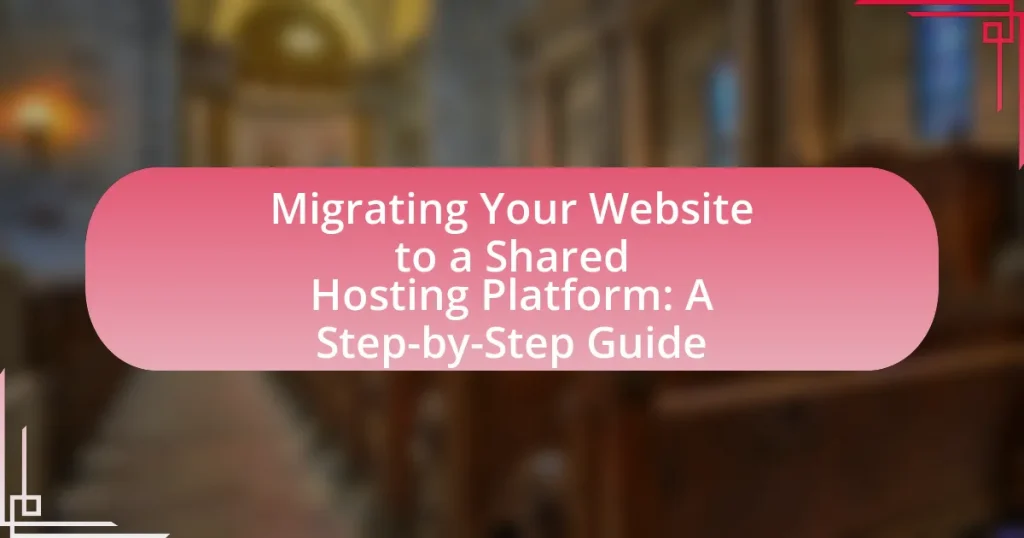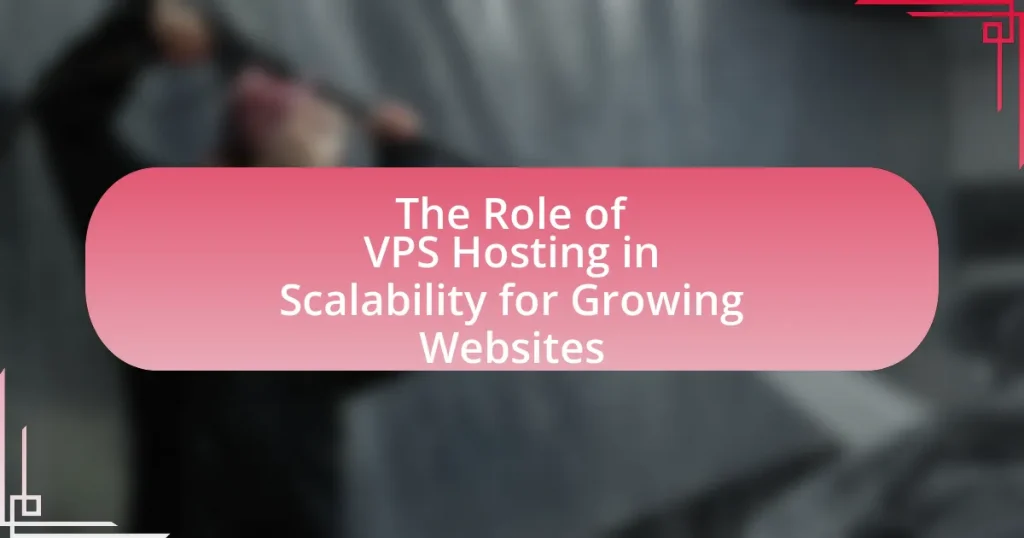Migrating your website to a shared hosting platform involves transferring files, databases, and configurations from your current host to a new provider. This process includes essential steps such as backing up data, setting up the new account, uploading files, importing databases, updating DNS settings, and testing functionality to ensure a smooth transition. Shared hosting is a cost-effective option for small businesses, offering user-friendly management tools and support. The article outlines the advantages of shared hosting, key migration steps, potential challenges, and best practices to ensure a successful migration while maintaining website performance and SEO integrity.

What does migrating your website to a shared hosting platform involve?
Migrating your website to a shared hosting platform involves transferring your website files, databases, and configurations from your current hosting environment to a new shared hosting provider. This process typically includes backing up your existing website data, setting up the new hosting account, uploading the website files to the new server, importing databases, updating domain settings, and testing the website functionality to ensure everything operates correctly post-migration. Each of these steps is crucial to ensure a smooth transition and minimize downtime, as evidenced by best practices in web hosting migration.
Why should you consider migrating to a shared hosting platform?
Migrating to a shared hosting platform is advisable due to its cost-effectiveness and ease of use. Shared hosting allows multiple websites to share a single server, significantly reducing hosting costs, often making it the most affordable option for small businesses and personal websites. According to a 2021 survey by HostingAdvice, 70% of small businesses prefer shared hosting for its low entry price, which typically ranges from $2 to $10 per month. Additionally, shared hosting platforms often provide user-friendly interfaces and customer support, making it easier for individuals with limited technical skills to manage their websites effectively.
What are the advantages of shared hosting for small businesses?
Shared hosting offers several advantages for small businesses, primarily cost-effectiveness, ease of use, and resource sharing. Cost-effectiveness is significant as shared hosting plans typically range from $2 to $10 per month, making it an affordable option for startups and small enterprises with limited budgets. Ease of use is another advantage, as most shared hosting providers offer user-friendly control panels and one-click installations, allowing business owners to manage their websites without extensive technical knowledge. Additionally, resource sharing allows multiple websites to utilize the same server resources, which can lead to lower operational costs and simplified maintenance, as the hosting provider handles server management and security updates. These factors collectively make shared hosting an attractive solution for small businesses looking to establish an online presence efficiently and economically.
How does shared hosting compare to other hosting options?
Shared hosting is generally more affordable and user-friendly compared to other hosting options like VPS (Virtual Private Server) and dedicated hosting. In shared hosting, multiple websites share the same server resources, which reduces costs significantly, making it ideal for small businesses and personal websites. In contrast, VPS and dedicated hosting provide more resources and control, catering to larger websites or those requiring specific configurations. According to a report by HostingAdvice, shared hosting plans can start as low as $2.75 per month, while VPS plans typically begin around $20 per month, highlighting the cost-effectiveness of shared hosting for entry-level users.
What are the key steps in the migration process?
The key steps in the migration process to a shared hosting platform include planning, backing up data, transferring files, updating DNS settings, and testing the new setup. Planning involves assessing the current website and determining the necessary resources on the new platform. Backing up data ensures that all website files, databases, and configurations are securely saved before migration. Transferring files can be done via FTP or a control panel, moving all necessary content to the new host. Updating DNS settings is crucial for directing traffic to the new server, which typically involves changing the nameservers. Finally, testing the new setup confirms that the website functions correctly on the shared hosting platform, ensuring that all features and functionalities are operational.
How do you prepare your website for migration?
To prepare your website for migration, first conduct a comprehensive backup of all website files and databases. This ensures that you have a complete copy of your site, which is crucial for restoring it in case of any issues during the migration process. According to a survey by SiteGround, 70% of website owners who experienced migration issues reported that having a backup saved them from data loss. Next, review and document your current website settings, including DNS records, email configurations, and any custom scripts or applications in use. This documentation will facilitate a smoother transition to the new hosting environment. Additionally, test the new hosting environment by setting up a staging site to ensure compatibility and performance before the final migration.
What tools can assist in the migration process?
Tools that can assist in the migration process include website migration plugins, FTP clients, and backup solutions. Website migration plugins, such as Duplicator and All-in-One WP Migration, streamline the transfer of files and databases, ensuring a smoother transition. FTP clients like FileZilla facilitate the uploading and downloading of files between local systems and the hosting server, while backup solutions, such as UpdraftPlus, ensure that all website data is securely stored before migration. These tools enhance efficiency and reduce the risk of data loss during the migration process.
What challenges might you face during migration?
During migration to a shared hosting platform, you might face challenges such as data loss, downtime, and compatibility issues. Data loss can occur if backups are not properly managed, leading to the potential loss of website content or user data. Downtime may happen during the transition, affecting user access and potentially harming your site’s reputation. Compatibility issues can arise if the new hosting environment does not support certain applications or configurations used in the previous setup, which can disrupt website functionality. These challenges are commonly reported in migration case studies, highlighting the importance of thorough planning and testing before executing the migration process.
How can you troubleshoot common migration issues?
To troubleshoot common migration issues, first identify the specific problem, such as broken links, missing files, or database connection errors. Next, verify that all files have been transferred correctly by comparing the source and destination directories. Additionally, check the configuration settings, including database credentials and file permissions, to ensure they match the new hosting environment. Use tools like website crawlers to detect broken links and monitor server response times for performance issues. According to a study by the Web Hosting Industry Review, 70% of migration problems stem from misconfigured settings, highlighting the importance of thorough checks during the migration process.
What are the risks associated with migrating to shared hosting?
Migrating to shared hosting carries several risks, including reduced performance, security vulnerabilities, and limited control over server configurations. Shared hosting means multiple websites share the same server resources, which can lead to slower loading times and potential downtime if one site experiences high traffic. Security is also a concern, as vulnerabilities in one website can expose others on the same server to attacks. Additionally, users have limited control over server settings and software, which can hinder the ability to optimize performance or implement specific security measures. These factors highlight the importance of carefully considering the implications of shared hosting before migration.

How do you execute the migration to a shared hosting platform?
To execute the migration to a shared hosting platform, first, back up all website files and databases from the current hosting environment. This ensures that all data is preserved and can be restored if needed. Next, choose a shared hosting provider that meets your website’s requirements, such as storage, bandwidth, and support. After signing up, upload the backed-up files to the new hosting account using FTP or the hosting provider’s file manager. Import the database using the hosting provider’s database management tool, ensuring that the database connection settings in your website’s configuration files are updated accordingly. Finally, update the domain’s DNS settings to point to the new shared hosting server, allowing users to access the website on the new platform. This process is validated by the fact that proper backups and DNS updates are critical steps in successful website migrations, as outlined in various web hosting guides.
What are the detailed steps to migrate your website?
To migrate your website, follow these detailed steps: First, back up your existing website files and databases to ensure data safety. Next, choose a new shared hosting provider and set up your account. After that, upload your website files to the new server using FTP or a file manager. Then, import your database to the new hosting environment using tools like phpMyAdmin. Update your website’s configuration files to reflect the new database settings. Finally, change your domain’s DNS settings to point to the new hosting provider, and test your website to ensure everything functions correctly. These steps are essential for a successful migration, as they minimize downtime and data loss.
How do you back up your website before migration?
To back up your website before migration, use a combination of file and database backups. First, access your website’s files via FTP or a file manager provided by your hosting service, and download all files to your local computer. This includes HTML, CSS, JavaScript, images, and any other media files. Next, back up your database by using a tool like phpMyAdmin, where you can export your database as an SQL file. This two-step process ensures that both your website’s files and its database are securely saved, allowing for a complete restoration if needed. Regular backups are essential, as they protect against data loss during migration.
What is the process for transferring files to the new host?
The process for transferring files to the new host involves several key steps. First, you need to create a backup of your website files from the current host, which can be done using an FTP client or a control panel file manager. Next, connect to the new host using the same FTP client and upload the backed-up files to the appropriate directory, typically the public_html folder. After the files are uploaded, ensure that all permissions are correctly set to allow the web server to access them. This process is validated by the standard practices in web hosting migrations, which emphasize the importance of backing up and correctly transferring files to maintain website functionality.
How do you configure your new shared hosting environment?
To configure your new shared hosting environment, first access the hosting control panel provided by your hosting provider. This control panel typically includes tools for managing files, databases, and domains. Next, upload your website files using the file manager or an FTP client, ensuring that the files are placed in the correct directory, usually the public_html folder. After uploading, create and configure a database if your website requires one, using the database management tool available in the control panel. Finally, update your domain’s DNS settings to point to your new hosting server, which may involve changing nameservers or A records. This process is validated by the fact that most shared hosting providers offer detailed documentation and support to assist users in setting up their environments correctly.
What settings need to be adjusted after migration?
After migration, the settings that need to be adjusted include DNS settings, database connection configurations, file permissions, and email settings. DNS settings must be updated to point to the new server’s IP address to ensure proper domain resolution. Database connection configurations should reflect the new database credentials and server details to maintain functionality. File permissions may require adjustments to ensure security and accessibility for the web application. Lastly, email settings should be reviewed to confirm that email services are correctly configured on the new hosting platform. These adjustments are essential for the seamless operation of the website post-migration.
How do you ensure your website is functioning properly post-migration?
To ensure your website is functioning properly post-migration, conduct thorough testing across all functionalities. This includes checking page load times, verifying that all links are operational, and ensuring that forms and interactive elements work as intended. Additionally, monitor for any broken images or missing content, as these issues can arise during migration. Utilizing tools like Google Search Console can help identify crawl errors, while performance monitoring tools can provide insights into site speed and uptime. Regularly reviewing server logs can also reveal any underlying issues that may affect website performance.
What should you do after the migration is complete?
After the migration is complete, you should verify that all website functionalities are working correctly. This includes checking links, forms, and media to ensure they function as intended. Additionally, you should monitor website performance and loading speed to confirm that the new hosting environment meets your requirements. Conducting a thorough review helps identify any issues that may have arisen during the migration process, ensuring a smooth transition to the shared hosting platform.
How can you monitor your website’s performance on the new host?
To monitor your website’s performance on the new host, utilize performance monitoring tools such as Google Analytics, GTmetrix, or Pingdom. These tools provide insights into page load times, uptime, and user interactions, allowing you to assess how well your website is functioning on the new hosting environment. For instance, Google Analytics tracks user behavior and site speed metrics, while GTmetrix offers detailed reports on loading times and performance scores. By regularly reviewing these metrics, you can identify any issues related to the new host and make necessary adjustments to optimize performance.
What steps should you take to optimize your website on shared hosting?
To optimize your website on shared hosting, you should implement caching, minimize resource usage, and optimize images. Caching reduces server load and speeds up page loading times by storing frequently accessed data. Minimizing resource usage involves limiting the number of plugins and scripts, which can enhance performance on shared servers with limited resources. Optimizing images by compressing them without losing quality decreases load times and improves user experience. These steps are essential as shared hosting environments often have constraints on bandwidth and processing power, making optimization crucial for maintaining website performance.

What best practices should you follow when migrating to shared hosting?
When migrating to shared hosting, it is essential to back up all website data to prevent loss during the transition. This includes files, databases, and configurations, ensuring that a complete copy is available for restoration if needed. Additionally, selecting a reliable shared hosting provider with good performance and support is crucial, as it directly impacts website uptime and user experience.
Testing the new hosting environment before fully switching over is another best practice; this allows for identifying any issues without affecting the live site. Furthermore, updating DNS settings only after confirming that the new hosting setup is functioning correctly helps avoid downtime.
Finally, monitoring the website post-migration is vital to quickly address any performance issues or errors that may arise, ensuring a smooth transition for users. These practices are supported by industry standards, which emphasize the importance of data integrity, provider reliability, and proactive management during hosting migrations.
How can you ensure a smooth migration experience?
To ensure a smooth migration experience, conduct thorough planning and testing before the actual migration. This involves creating a detailed migration checklist that includes backing up all website data, verifying compatibility with the new hosting environment, and testing the migration process in a staging environment. According to a study by the Web Hosting Industry Review, 70% of migration issues arise from inadequate preparation, highlighting the importance of these steps. Additionally, maintaining clear communication with your hosting provider can help address potential issues proactively, further ensuring a seamless transition.
What are the common mistakes to avoid during migration?
Common mistakes to avoid during migration include failing to back up data, not testing the new environment, and neglecting to update DNS settings. Failing to back up data can lead to irreversible loss if issues arise during the migration process. Not testing the new environment before fully switching can result in unexpected downtime or functionality issues. Additionally, neglecting to update DNS settings can cause visitors to be directed to the old site, leading to confusion and potential loss of traffic. These mistakes can significantly impact the success of the migration and the overall user experience.
How can you prepare for potential downtime during migration?
To prepare for potential downtime during migration, create a detailed migration plan that includes a timeline and a rollback strategy. This plan should outline the steps for data transfer, DNS updates, and testing phases to minimize disruption. Additionally, schedule the migration during off-peak hours to reduce the impact on users. According to a study by the Content Marketing Institute, 70% of businesses that plan for downtime experience less disruption, highlighting the importance of preparation.
What resources are available for assistance during migration?
Resources available for assistance during migration include web hosting provider support, online migration tools, and community forums. Web hosting providers often offer dedicated migration services or customer support to help users transition their websites smoothly. Online migration tools, such as Duplicator or All-in-One WP Migration, facilitate the transfer of website files and databases with minimal technical knowledge required. Additionally, community forums like Stack Overflow or specific hosting provider forums provide a platform for users to seek advice and share experiences related to website migration. These resources collectively ensure that users have access to the necessary support and tools for a successful migration process.
Where can you find tutorials and guides for website migration?
You can find tutorials and guides for website migration on various platforms such as official hosting provider websites, tech blogs, and video tutorial sites. For instance, companies like Bluehost and SiteGround offer comprehensive guides tailored to their services, while websites like WPBeginner and Smashing Magazine provide general tutorials applicable to various platforms. Additionally, YouTube hosts numerous video tutorials that visually demonstrate the migration process, making it easier for users to follow along. These resources are widely recognized for their accuracy and user-friendliness, ensuring that individuals can effectively navigate the website migration process.
How can you leverage customer support from your new hosting provider?
You can leverage customer support from your new hosting provider by utilizing their resources for troubleshooting, guidance, and optimization of your website. Most hosting providers offer 24/7 support through various channels such as live chat, email, and phone, allowing you to resolve issues quickly. Additionally, many providers have extensive knowledge bases and tutorials that can help you understand their services better and optimize your website’s performance. For instance, a study by HostingAdvice found that 70% of users reported improved website performance after consulting customer support for optimization tips.
What are the final tips for a successful migration to shared hosting?
To ensure a successful migration to shared hosting, it is crucial to back up all website data, including files and databases, before initiating the transfer. This step protects against data loss during the migration process. Additionally, testing the website on the new shared hosting environment before making the final switch is essential to identify any potential issues. It is also advisable to update DNS settings only after confirming that the website functions correctly on the new server. Furthermore, reviewing the shared hosting provider’s support and resources can facilitate a smoother transition. These practices are supported by industry standards, which emphasize the importance of data integrity and functionality during hosting migrations.
How can you maintain your website’s SEO during and after migration?
To maintain your website’s SEO during and after migration, implement 301 redirects for all existing URLs to their new counterparts. This ensures that search engines and users are directed to the correct pages, preserving link equity and minimizing traffic loss. Additionally, update your XML sitemap and submit it to search engines to reflect the new structure, which aids in indexing. Monitor your website’s performance using tools like Google Search Console to identify any crawl errors or issues post-migration. According to a study by Moz, proper implementation of redirects can help retain up to 90% of organic traffic during a migration.
What ongoing maintenance should you consider after migrating?
After migrating to a shared hosting platform, ongoing maintenance should include regular backups, software updates, security monitoring, and performance optimization. Regular backups ensure that data can be restored in case of loss, while software updates keep the website secure and functioning properly. Security monitoring helps identify and mitigate potential threats, and performance optimization ensures that the website runs efficiently, improving user experience. These practices are essential for maintaining website integrity and reliability post-migration.















